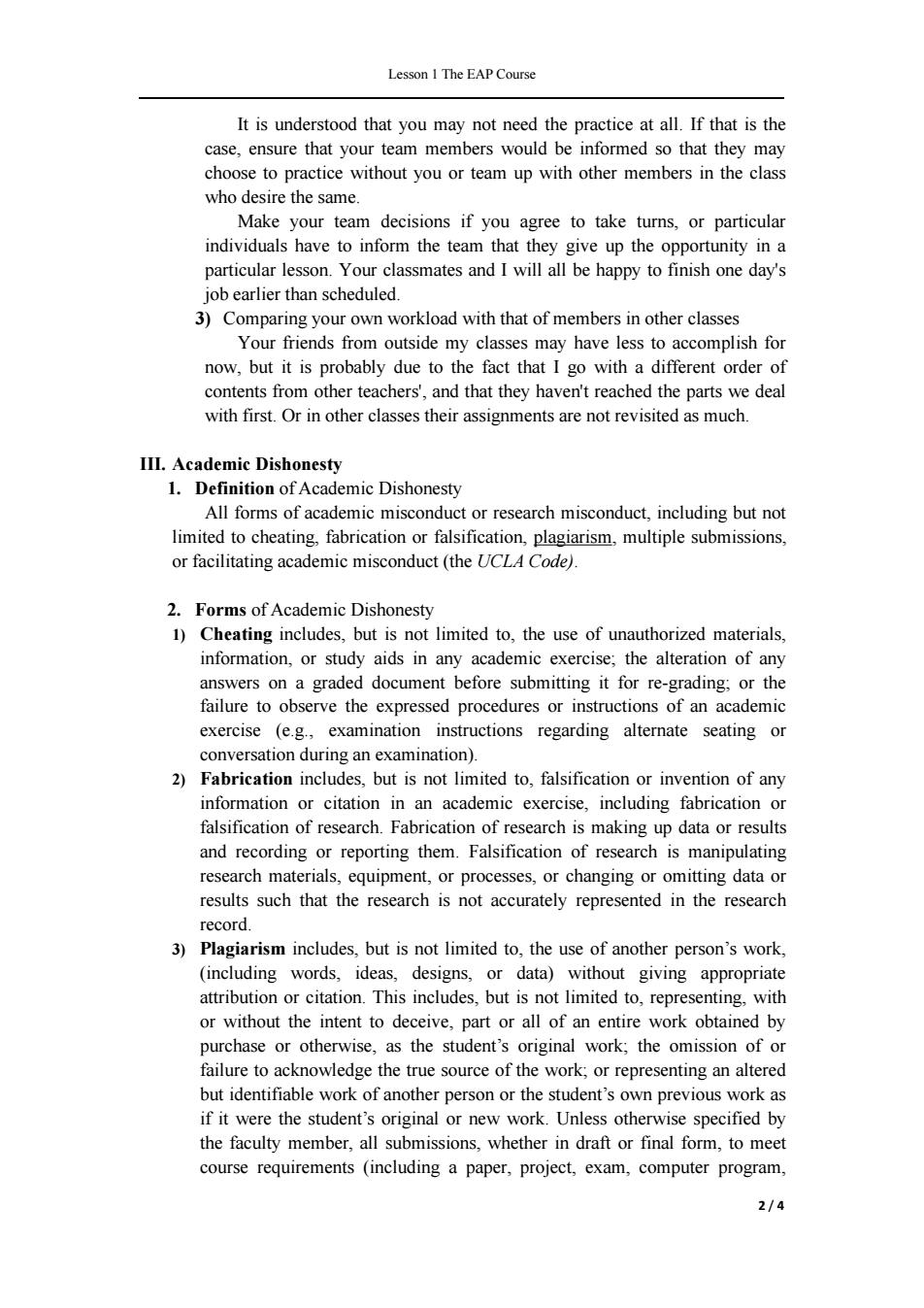正在加载图片...

Lesson 1 The EAP Course It is understood that you may not need the practice at all.If that is the case,ensure that your team members would be informed so that they may choose to practice without you or team up with other members in the class who desire the same. Make your team decisions if you agree to take turns,or particular individuals have to inform the team that they give up the opportunity in a particular lesson.Your classmates and I will all be happy to finish one day's job earlier than scheduled. 3)Comparing your own workload with that of members in other classes Your friends from outside my classes may have less to accomplish for now,but it is probably due to the fact that I go with a different order of contents from other teachers',and that they haven't reached the parts we deal with first.Or in other classes their assignments are not revisited as much. III.Academic Dishonesty 1.Definition of Academic Dishonesty All forms of academic misconduct or research misconduct,including but not limited to cheating,fabrication or falsification,plagiarism,multiple submissions, or facilitating academic misconduct (the UCLA Code). 2.Forms of Academic Dishonesty 1)Cheating includes,but is not limited to,the use of unauthorized materials, information,or study aids in any academic exercise;the alteration of any answers on a graded document before submitting it for re-grading;or the failure to observe the expressed procedures or instructions of an academic exercise (e.g.,examination instructions regarding alternate seating or conversation during an examination). 2)Fabrication includes,but is not limited to,falsification or invention of any information or citation in an academic exercise,including fabrication or falsification of research.Fabrication of research is making up data or results and recording or reporting them.Falsification of research is manipulating research materials,equipment,or processes,or changing or omitting data or results such that the research is not accurately represented in the research record. 3)Plagiarism includes,but is not limited to,the use of another person's work, (including words,ideas,designs,or data)without giving appropriate attribution or citation.This includes,but is not limited to,representing,with or without the intent to deceive,part or all of an entire work obtained by purchase or otherwise,as the student's original work;the omission of or failure to acknowledge the true source of the work;or representing an altered but identifiable work of another person or the student's own previous work as if it were the student's original or new work.Unless otherwise specified by the faculty member,all submissions,whether in draft or final form,to meet course requirements (including a paper,project,exam,computer program, 2/4Lesson 1 The EAP Course 2 / 4 It is understood that you may not need the practice at all. If that is the case, ensure that your team members would be informed so that they may choose to practice without you or team up with other members in the class who desire the same. Make your team decisions if you agree to take turns, or particular individuals have to inform the team that they give up the opportunity in a particular lesson. Your classmates and I will all be happy to finish one day's job earlier than scheduled. 3) Comparing your own workload with that of members in other classes Your friends from outside my classes may have less to accomplish for now, but it is probably due to the fact that I go with a different order of contents from other teachers', and that they haven't reached the parts we deal with first. Or in other classes their assignments are not revisited as much. III. Academic Dishonesty 1. Definition of Academic Dishonesty All forms of academic misconduct or research misconduct, including but not limited to cheating, fabrication or falsification, plagiarism, multiple submissions, or facilitating academic misconduct (the UCLA Code). 2. Forms of Academic Dishonesty 1) Cheating includes, but is not limited to, the use of unauthorized materials, information, or study aids in any academic exercise; the alteration of any answers on a graded document before submitting it for re-grading; or the failure to observe the expressed procedures or instructions of an academic exercise (e.g., examination instructions regarding alternate seating or conversation during an examination). 2) Fabrication includes, but is not limited to, falsification or invention of any information or citation in an academic exercise, including fabrication or falsification of research. Fabrication of research is making up data or results and recording or reporting them. Falsification of research is manipulating research materials, equipment, or processes, or changing or omitting data or results such that the research is not accurately represented in the research record. 3) Plagiarism includes, but is not limited to, the use of another person’s work, (including words, ideas, designs, or data) without giving appropriate attribution or citation. This includes, but is not limited to, representing, with or without the intent to deceive, part or all of an entire work obtained by purchase or otherwise, as the student’s original work; the omission of or failure to acknowledge the true source of the work; or representing an altered but identifiable work of another person or the student’s own previous work as if it were the student’s original or new work. Unless otherwise specified by the faculty member, all submissions, whether in draft or final form, to meet course requirements (including a paper, project, exam, computer program